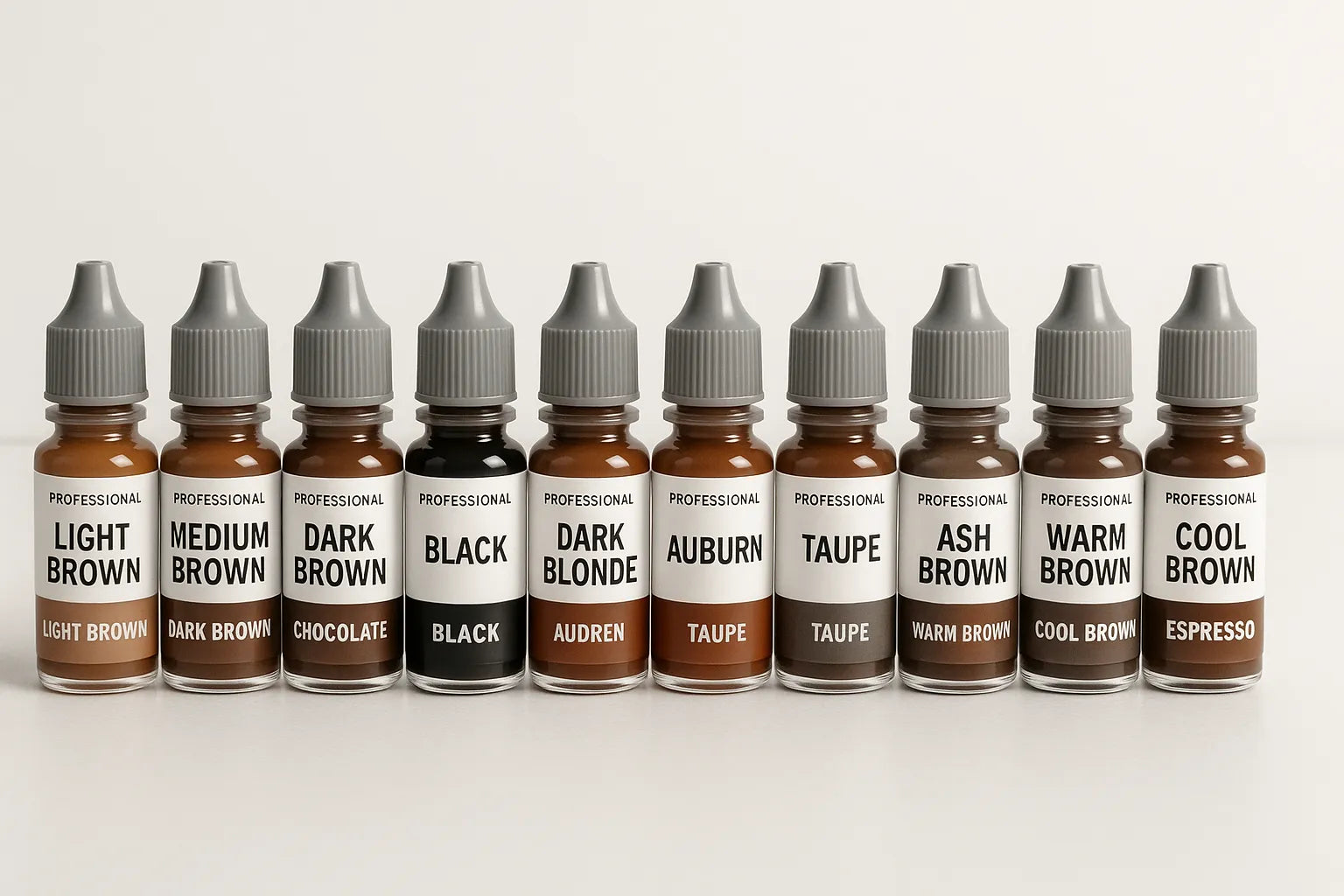PMU Pigment Color Matching Skin Tones: The Complete Guide to Perfect Results
Permanent makeup (PMU) has revolutionized the beauty industry, offering clients long-lasting solutions for eyebrows, eyeliner, and lip color. However, the success of any PMU procedure heavily depends on one crucial factor: PMU pigment color matching skin tones. Getting this right can mean the difference between a natural, flattering look and an obvious, artificial appearance that clients regret.
Color matching in permanent makeup is both an art and a science. It requires understanding undertones, skin characteristics, and how pigments interact with different skin types over time. Whether you're a seasoned PMU artist or just starting your career, mastering pigment color matching will elevate your work and ensure client satisfaction.
In this comprehensive guide, we'll explore everything you need to know about PMU pigment color matching skin tones, from understanding the fundamentals to advanced techniques that will help you achieve flawless results every time.
Understanding Skin Undertones: The Foundation of PMU Color Matching
Before diving into pigment selection, it's essential to understand that skin tone consists of two components: the surface tone (what you see) and the undertone (the subtle hue beneath the surface). PMU pigment color matching skin tones requires identifying these undertones accurately, as they significantly influence how pigments will appear once healed.
The Three Primary Undertones
Cool Undertones: Characterized by pink, red, or blue hues beneath the skin surface. People with cool undertones often have veins that appear blue or purple and may burn easily in the sun. They typically look best in silver jewelry and colors like blue, purple, and emerald green.
Warm Undertones: Feature yellow, golden, or peach hues. Those with warm undertones usually have greenish-appearing veins, tan easily, and look stunning in gold jewelry. They're complemented by colors like orange, yellow, and warm reds.
Neutral Undertones: A balanced mix of cool and warm undertones. People with neutral undertones have veins that appear blue-green, can wear both gold and silver jewelry, and are complemented by a wide range of colors.
Methods for Identifying Undertones
Several techniques can help you accurately identify your client's undertones for optimal PMU pigment color matching skin tones:
- Vein Test: Examine the veins on the inner wrist under natural light
- White Paper Test: Hold white paper next to the face to see which undertones become apparent
- Jewelry Test: Observe whether gold or silver jewelry complements the skin better
- Sun Reaction: Consider how the skin reacts to sun exposure
The Science Behind PMU Pigment Color Matching
Understanding how pigments interact with skin is crucial for successful PMU pigment color matching skin tones. Unlike traditional makeup, PMU pigments are deposited into the dermal layer of the skin, where they interact with the client's natural undertones and melanin levels.
Pigment Composition and Behavior
PMU pigments are typically composed of iron oxides, organic compounds, or a combination of both. These pigments behave differently in various skin types:
- Iron Oxide Pigments: More stable and fade predictably, making them ideal for most skin tones
- Organic Pigments: Offer vibrant colors but may fade differently across skin types
- Hybrid Pigments: Combine the benefits of both types for optimal color retention
Factors Affecting Pigment Appearance
Several factors influence how pigments appear in the skin and must be considered during PMU pigment color matching skin tones:
- Melanin Content: Higher melanin levels can affect pigment visibility and color appearance
- Skin Thickness: Thicker skin may require different pigment concentrations
- Age: Mature skin may have different absorption and healing characteristics
- Lifestyle Factors: Sun exposure, skincare routines, and medications can impact pigment longevity
Color Theory for PMU Artists
Mastering color theory is essential for effective PMU pigment color matching skin tones. Understanding how colors interact, complement, and neutralize each other will help you create the most natural and flattering results.
The Color Wheel in PMU
The color wheel serves as your guide for understanding color relationships:
- Complementary Colors: Opposite colors on the wheel that neutralize each other
- Analogous Colors: Adjacent colors that create harmony
- Triadic Colors: Three evenly spaced colors that create vibrant contrast
Neutralizing Unwanted Tones
Sometimes, you'll need to counteract unwanted undertones in the skin or existing pigment. Understanding color correction principles is vital:
- Orange neutralizes blue tones
- Green neutralizes red tones
- Purple neutralizes yellow tones
- Yellow neutralizes purple tones
Practical Techniques for PMU Pigment Color Matching
Now that you understand the theory, let's explore practical techniques for PMU pigment color matching skin tones that will ensure consistent, beautiful results.
The Consultation Process
A thorough consultation is the foundation of successful color matching:
- Analyze in Natural Light: Always assess skin tones under natural daylight for accuracy
- Document Everything: Take photos and notes about undertones, preferences, and lifestyle factors
- Consider the Client's Goals: Understand whether they want natural enhancement or more dramatic results
- Discuss Expectations: Explain how colors may appear immediately versus after healing
Color Matching Tools and Techniques
Professional PMU artists use various tools to ensure accurate PMU pigment color matching skin tones:
- Color Matching Cards: Use professional color cards to compare against skin tones
- Digital Color Analysis: Utilize apps and devices designed for color matching
- Test Patches: When in doubt, perform small test patches to see how pigments heal
- Pigment Mixing: Learn to blend pigments to create custom colors
Specific Guidelines for Different PMU Procedures
Each PMU procedure has unique considerations for PMU pigment color matching skin tones. Let's explore the specifics for the most common treatments.
Eyebrow PMU Color Matching
Eyebrow color should complement both the client's natural hair color and skin undertones:
- Cool Undertones: Choose ashy or cool-toned browns, avoiding warm or golden hues
- Warm Undertones: Opt for warm browns with golden or reddish undertones
- Neutral Undertones: Can wear most brown shades, but avoid extremes
Consider the client's hair color as well:
- Blonde hair: Go 1-2 shades darker than the hair
- Brown hair: Match or go slightly lighter
- Black hair: Use dark brown rather than pure black
- Red hair: Incorporate warm, reddish undertones
Eyeliner PMU Considerations
Eyeliner color matching focuses on enhancing the natural eye color while complementing skin undertones:
- Classic Black: Suitable for most skin tones but may appear harsh on very fair skin
- Dark Brown: More natural-looking option for lighter skin tones
- Custom Colors: Consider the client's eye color and personal style preferences
Lip PMU Color Selection
Lip color matching requires careful consideration of natural lip color and undertones:
- Enhancement: Choose colors that are 1-2 shades deeper than natural lip color
- Neutralization: Address any unwanted undertones in the natural lip color first
- Lifestyle Compatibility: Consider the client's professional and personal style requirements
Common Mistakes in PMU Color Matching and How to Avoid Them
Even experienced artists can make mistakes when it comes to PMU pigment color matching skin tones. Here are the most common pitfalls and how to avoid them:
Mistake #1: Ignoring Undertones
Many artists focus only on the surface skin tone, ignoring the underlying undertones that significantly impact the final result. Always identify and consider undertones in your color selection process.
Mistake #2: Using Artificial Lighting
Fluorescent or LED lighting can distort color perception. Always perform color matching under natural daylight or use daylight-balanced lighting systems.
Mistake #3: Not Considering Fading Patterns
Different pigments fade differently across various skin types. Research and understand how your chosen pigments will age in different skin tones.
Mistake #4: One-Size-Fits-All Approach
What works for one client may not work for another, even with similar skin tones. Always customize your approach based on individual characteristics.
Advanced Color Matching Strategies
For experienced PMU artists looking to refine their PMU pigment color matching skin tones skills, these advanced strategies can help achieve even better results:
Seasonal Color Analysis
Incorporate seasonal color analysis principles to determine which color families work best for each client:
- Spring Types: Warm undertones with light to medium skin, benefit from warm, clear colors
- Summer Types: Cool undertones with light to medium skin, look best in cool, muted colors
- Autumn Types: Warm undertones with medium to deep skin, enhanced by rich, warm colors
- Winter Types: Cool undertones with light to deep skin, complemented by cool, clear colors
Custom Pigment Mixing
Learn to create custom colors by mixing pigments:
- Start with small amounts and document ratios
- Test mixed pigments on practice skin before using on clients
- Consider how mixed pigments will fade over time
- Keep detailed records of successful custom mixes
Corrective Color Matching
Sometimes you'll need to correct previous PMU work:
- Assess the existing pigment and its undertones
- Determine the best approach: color correction, removal, or camouflage
- Use color theory to neutralize unwanted tones
- Plan treatments in phases for optimal results
Tools and Products for Successful Color Matching
Having the right tools is essential for accurate PMU pigment color matching skin tones. Here's what every PMU artist should have in their toolkit:
Essential Color Matching Tools
- Daylight Lamps: Provide consistent, natural lighting for color assessment
- Color Matching Fans: Professional tools showing various skin tones and undertones
- Digital Color Analyzers: High-tech devices for precise color measurement
- Color Mixing Palettes: Clean surfaces for testing and mixing pigments
- Photography Equipment: Document before, during, and after results
Quality Pigment Lines
Invest in reputable pigment brands known for:
- Consistent color performance
- Predictable fading patterns
- Wide range of undertones
- Safety certifications
- Detailed color information
Maintaining Color Integrity: Aftercare and Touch-ups
Successful PMU pigment color matching skin tones doesn't end with the initial procedure. Proper aftercare and strategic touch-ups ensure long-lasting, beautiful results.
Client Education on Aftercare
Educate clients on how to maintain their PMU:
- Sun protection to prevent premature fading
- Proper skincare routines that won't affect pigment
- When to schedule touch-up appointments
- Signs that indicate color adjustment may be needed
Planning Touch-up Sessions
Touch-ups are opportunities to perfect color matching:
- Assess how the initial color has settled and healed
- Make adjustments based on the healed result
- Address any areas that may need color enhancement
- Document changes for future reference
The Future of PMU Color Matching Technology
The field of PMU pigment color matching skin tones continues to evolve with technological advances:
Digital Color Matching Systems
Advanced software and apps are being developed to:
- Analyze skin tones with greater precision
- Predict how pigments will appear after healing
- Create virtual previews of results
- Store client color profiles for future reference
Improved Pigment Formulations
Manufacturers are developing pigments with:
- Better color stability across different skin types
- More predictable fading patterns
- Enhanced safety profiles
- Broader range of undertones
Building Your Color Matching Expertise
Mastering PMU pigment color matching skin tones is an ongoing journey that requires continuous learning and practice:
Education and Training
- Attend workshops focused on color theory and matching
- Study with experienced artists known for excellent color work
- Practice on diverse skin tones to build experience
- Stay updated on new pigments and techniques
Building a Portfolio
Document your color matching successes:
- Photograph before and after




